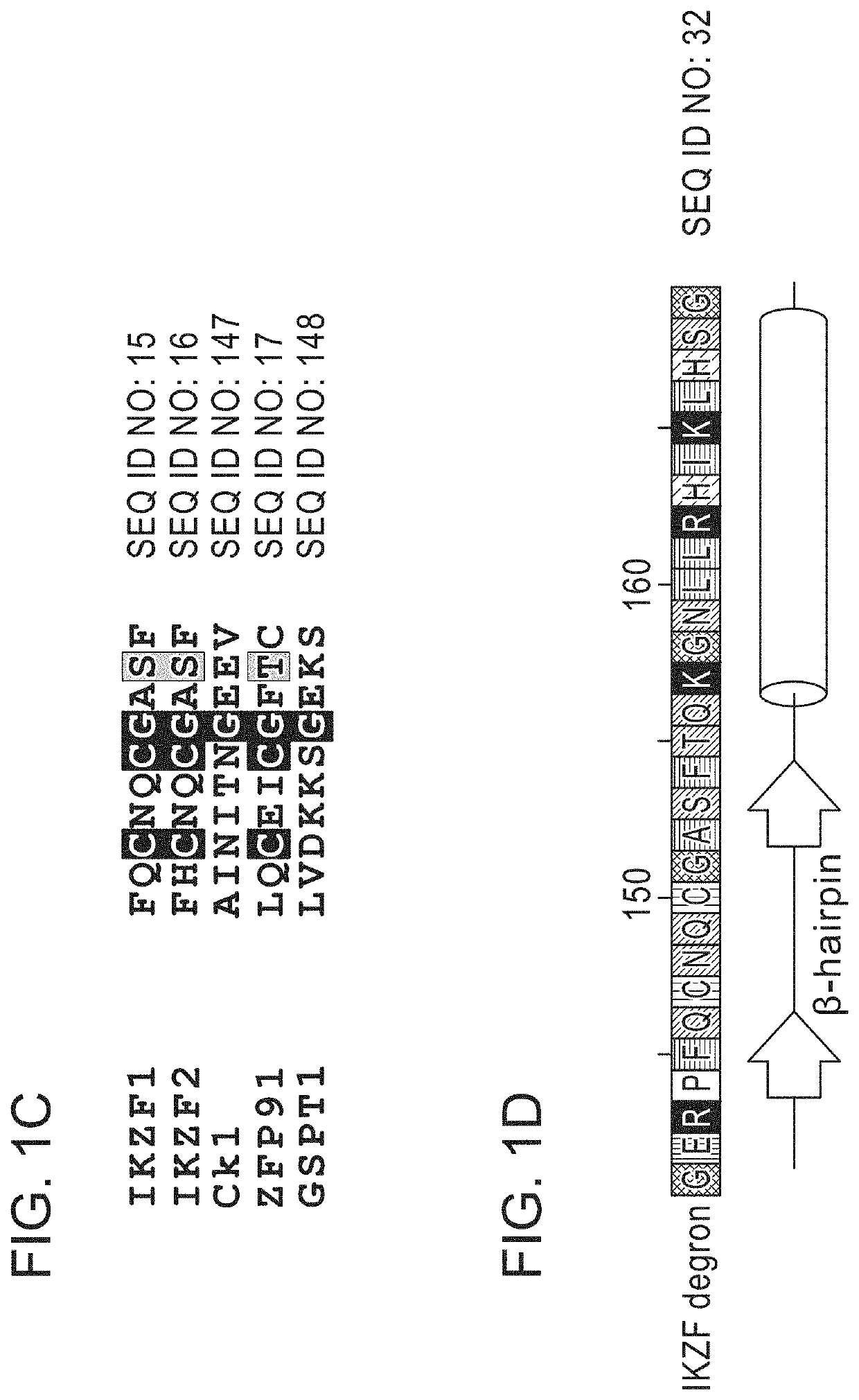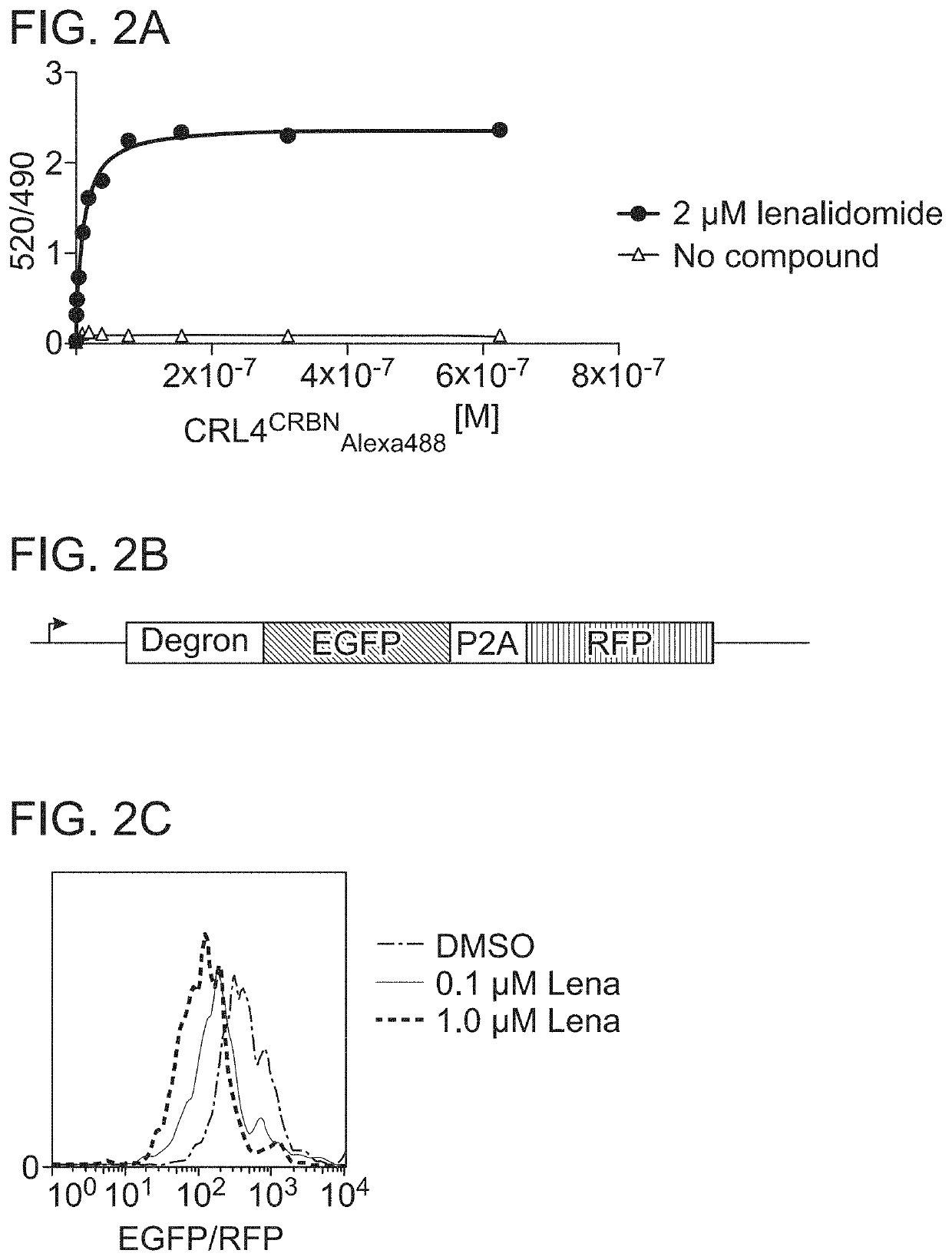Peptide tags for ligand induced degradation of fusion proteins
a technology of fusion proteins and peptide tags, which is applied in the direction of peptides, immunoglobulins against animals/humans, and drug compositions, can solve the problems of slow onset of control of protein expression through repression of transcription, inability to disrupt the function of any protein using a small molecule, and inability to predict the abundance of mrna and protein abundance, etc., to achieve the effect of minimal modification of the target protein, universal applicability of the target protein
- Summary
- Abstract
- Description
- Claims
- Application Information
AI Technical Summary
Benefits of technology
Problems solved by technology
Method used
Image
Examples
example 2
on of Degron Tag-GFP N-Terminal Fusion Protein
[0230]The degradation of degron tag-GFP N-terminal fusion protein, which was monitored by time-resolved fluorescence energy transfer (TR-FRET), is described in Petzold et al., Nature 532:127-130 (2016) (FIG. 2A-FIG. 2C).
example 3
al Characterization of SALL4 Degron Binding to CRBN Using Time-Resolved Fluorescence Resonance Energy Transfer (TR-FRET)
[0231]Compounds in binding assays were dispensed into a 384-well microplate (Corning, 4514) using the D300e Digital Dispenser (HP) normalized to 1% DMSO and containing 100 nM biotinylated Strep-Avi-SALL4 (WT or mutant, see, FIG. 3A-FIG. 3K), 1 μM His6-DDB1ΔB-His6-CRBNBODIPY-Spycatcher and 4 nM terbium-coupled streptavidin (Invitrogen) in a buffer containing 50 mM Tris pH 7.5, 100 mM NaCl, 1 mM TCEP, 0.1% Pluronic F-68 solution (Sigma). Before TR-FRET measurements were conducted, the reactions were incubated for 15 minutes at room temperature (RT). After excitation of terbium fluorescence at 337 nm, emission at 490 nm (terbium) and 520 nm (boron-dipyrromethene (BODIPY)) were recorded with a 70 μs delay over 600 μs to reduce background fluorescence and the reaction was followed over 30×200 second cycles of each data point using a PHERAstar® FS microplate reader (BMG ...
example 4
2 is the Zinc Finger Responsible for IMiD-Dependent Binding to CRL4CRBN
[0233]Kelly cells were transiently transfected with hsSALL4G416A or Flag-hsSALL4G416N were treated with increasing concentrations of thalidomide or DMSO as a control. Following 24 hours of incubation, SALL4 (α-Flag) and GAPDH protein levels were assessed by western blot analysis (FIG. 4A). (See, Example 7 for western blot method.)
[0234]Results are shown in FIG. 4A-FIG. 4H. The degron tags of SEQ ID NO's: 26-28 were validated in biochemical assays. SALL4 ZnF2 (SEQ ID NO: 26) and SALL4 ZnF1-2 (SEQ ID NO: 27) were sufficient to induce efficient dimerization, while SALL4 ZnF4 (SEQ ID NO: 28) binds with reduced affinity.
[0235]Mutations of key glycine 416 residue in Znf2 of SALL4 (G416A and G416N) disable degradation in cells (FIG. 4A). Surprisingly, mutations of conserved glycine in ZnF4 of SALL4 to alanine or asparagine have no effect on protein degradation (FIG. 4H).
PUM
| Property | Measurement | Unit |
|---|---|---|
| pH | aaaaa | aaaaa |
| pH | aaaaa | aaaaa |
| pH | aaaaa | aaaaa |
Abstract
Description
Claims
Application Information
 Login to View More
Login to View More - Generate Ideas
- Intellectual Property
- Life Sciences
- Materials
- Tech Scout
- Unparalleled Data Quality
- Higher Quality Content
- 60% Fewer Hallucinations
Browse by: Latest US Patents, China's latest patents, Technical Efficacy Thesaurus, Application Domain, Technology Topic, Popular Technical Reports.
© 2025 PatSnap. All rights reserved.Legal|Privacy policy|Modern Slavery Act Transparency Statement|Sitemap|About US| Contact US: help@patsnap.com



